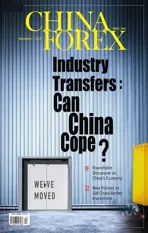From “Made in China” to“Chinese Assets”
2019-03-23ByXieYaxuan
By Xie Yaxuan
T he Sino-US trade dispute has proved once again the importance of the “Made in China”label. Being at the center of global manufacturing, China is not only providing manufactured goods to the whole world but is also serving as an organizer of global commodity manufacturing activities. This is behind the trade friction between China and the US and the result will not only be felt by the two parties but will also have global repercussions.
The latest figures show that Sino-US trade friction has led to a contraction of demand in China, and the impact has since been transmitted through the global supply chain lines to other economies including South Korea, China's Taiwan, Japan and the euro zone – most notably Germany.China’s processing trade exports, for example, fell 7.3% year-on-year over the first three quarters of 2019, while processing imports had an even more rapid year-on-year decline of 11.7%.
Meanwhile, Germany’s manufacturing PMI fell to a record low of 41.7% in September. In addition, according to estimates of the World Bank, global GDP growth in 2019 will fall to 3.0% from 3.6% in 2018, trade volume growth will fall from 3.7% to 0.9%, and increased tariffs have already resulted in a sharp drop in global trade elasticity from the normal level of 1.0-1.3.
The risk of a global recession and a downward spiral in foreign trade is increasing.
Currently, countries around the world are taking active steps to strengthen policy coordination and head off recession. Indirectly, this is making “Chinese assets” increasingly important on the global stage —alongside the “Made in China” label.
“Made in China” will bring near term benefits to Chinese assets. China was the first country affected by Sino-US friction, so it was the first to respond. China is expected to take the lead in stabilizing its economy.
China is also one of the few economies with a full panoply of manufacturing. As a result, Chinese assets will gain much from trade and manufacturing stabilization.
China is not only providing manufactured goods to the whole world but is also serving as an organizer of global commodity manufacturing activities.
Despite the rise of the “antiglobalization” movement, China has honored its pledges to open up its financial markets and has gradually removed institutional obstacles to international capital in the domestic equity and bond markets.
Moreover, global bond prices have weakened under the effects of loose monetary policies used to counter trade friction. The use of negative interest rates has expanded and the global tally of bonds with negative interest rates has reached US$17 trillion. Negative interest rates in the euro area and Japan may lead to a decline in the attractiveness of assets denominated in those currencies, and alternative international assets will be in demand. That has made Chinese bonds look even more attractive to global investors.
China has played another important role in the global economy.Thanks to the nation’s economic reforms, China has achieved continuous growth in national income. During this process, China has been increasing its holdings of international assets such as US Treasury bonds and eurozone government bonds, promoting an international monetary cycle that goes hand in hand with the commodity cycle.
In the future, trade disruptions from the Sino-US trade dispute may reduce the US current account deficit, and that may diminish the role of the dollar in the cycling of global currency. This will require another international asset to fill the gap.
With the transformation and upgrading of China’s economic structure, the nation may see periodic deficits in its own current account –unlike in the past years when China had large and sustained surpluses.If China maintains its advantages in manufacturing, there will be inflows of international capital. This is quite close to the stage of transition from mature debtor country to young creditor country as outlined in the balance of payments life cycle theory.For these reasons Chinese assets will move to the center of the global stage and capture the attention of international investors.
In turn, the increase in international holdings of “Chinese assets” will also have a more important impact on China’s capital markets and asset prices. In 2017,there was a substantial upswing in demand for Chinese stocks from international investors due to preferences for large-cap, lowvaluation shares and shares that traded at a reasonable premium over Hong Kong shares.
In February and March 2018, the renminbi beat all expectations of market analysts, appreciating to 6.25 to the dollar. International reserve data released by the International Monetary Fund and the Russian Central Bank later showed that the Russian central bank converted about US$45 billion of its international dollar reserves into renminbi reserves, and this was a major factor in the currency’s advance.
In the first half of 2019, the widening of the spread between Chinese government bonds and China development bonds was also attributed to the substantial increase of holdings in development bonds by international investors. Looking ahead to 2020, whether international investors will become a new driver for China’s bond market and whether the increase of global capital will lead to lower interest rates on China’s government bonds are all issues of importance to the market. Whatever the answers to these key questions,China will see a more diversified capital market in the coming year as it pushes ahead with the opening up of its economy.
杂志排行
China Forex的其它文章
- Data
- New Policies to Aid Cross-Border Investment
- Capital Account Convertibility and China’s Drive to Open its Financial Sector
- Q & A On the Notice by the State Administration of Foreign Exchange on Further Facilitating Cross-Border Trade and Investment
- Combining Cross-Border Direct Loans and Foreign Exchange Derivatives
- China’s Cross-Border E-Commerce: Growth But Challenges Ahead
